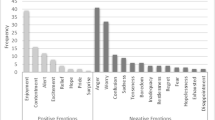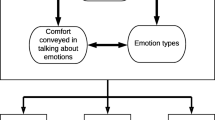Abstract
Science teaching environments are social environments, and teachers’ emotions interact with their science teaching in powerful ways. To value the teacher is to value the whole person, not just the intellect. In this paper, a theorization of teacher emotion in science teaching is developed which illustrates the role of emotion in establishing and maintaining self-esteem in science teaching situations. From the standpoint of social-constructionist theory of emotion, it is argued that emotion is a social construction within social relationships. Arising from this view, are the emotions of intellectual excitement, frustration and shame that play a key role in the development of self-esteem. The dynamics of these emotions, in the context of experiences of success and failure, may dispose teachers to act positively or negatively towards science teaching. The theorisation developed is illustrated in the emotional experiences of an elementary school teacher in an early childhood science classroom. These experiences indicate that emotion is constitutive of teaching, and merits greater consideration in science teaching.
Similar content being viewed by others
References
Adams, V. M. (1989). Affective issues in teaching problem solving: A teacher’s perspective. In D. McLeod & V. Adams (Eds.), Affect and mathematical problem solving: A new perspective (pp. 192–201). New York: Springer-Verlag.
American Association for the Advancement of Science (AAAS). ( 1993). Benchmarks for science literacy. New York: Oxford University Press.
Armon-Jones, C. (1986). The thesis of constructionism. In R. Harré (Ed.), The social construction of emotions (pp. 33–56). Oxford, UK: Blackwell.
Averill, J. R. (1980). A constructivist view of emotion. In R. Plutchik & H. Kellerman (Eds.), Emotion: Theory, research and experience (Vol. 1, pp. 305–339). New York: Academic Press.
Barbalet, J. (1998). Emotion, social theory and social structure. Cambridge, UK: Cambridge University Press.
Barker, H. B. (2001). A room of one’s own: Concrete and conceptual spaces. In M. Osborne & A. Barton (Eds.), Teaching science in diverse settings: Marginalized discourses and classroom practice (pp. 59–78). New York: Peter Lang.
Bartky, S. (1990). Femininity and domination. New York: Routledge.
Bibby, T. (2002). Shame: An emotional response to doing mathematics as an adult and a teacher. British Educational Research Journal, 28, 705–721.
Campbell, S. (1994). Being dismissed: The politics of emotional expression. Hypatia, 9, 46–65.
Campbell, S. (1997). Interpreting the personal: Expression and the formation of feelings. Ithaca, NY: Cornell University Press.
Cornelius, R. R. (1996). The science of emotion: Research and tradition in the psychology of emotion. Upper Saddle River, NJ: Prentice Hall.
Crawford, J., Kippax, S., Onyx, J., Gault, U., & Benton, P. (1992). Emotion and gender: Constructing meaning from memory. London: Sage.
Day, C., & Leitch, R. (2001). Teachers’ and teacher educators’ lives: The role of emotion. Teaching and Teacher Education, 17, 403–415.
Denzin, N. K. (1984). On understanding emotion. San Francisco: Jossey-Bass.
Denzin, N. K. (1997). Interpretive ethnography: Ethnographic practices for the 21st century. Thousand Oaks, CA: Sage.
Ernest, P. (1995). The one and the many. In L. Steffe & J. Gale (Eds.), Constructivism in education (pp. 459–486). Mahwah, NJ: Lawrence Erlbaum.
Farber, B. A. (1991). Crisis in education: Stress and burnout in the American teacher. San Francisco: Jossey-Bass.
Frijda, N. H. (1986). The emotions. Cambridge, UK: Cambridge University Press.
Frijda, N. H. (1994). Emotions are functional, most of the time. In P. Ekman & R. Davidson (Eds.), The nature of emotion: Fundamental questions (pp. 112–126). New York: Oxford University Press.
Hargreaves, A. (1998a). The emotional practice of teaching. Teaching and Teacher Education, 14, 835–854.
Hargreaves, A. (1998b). The emotional politics of teaching and teacher development: with implications for educational leadership. International Journal of Leadership in Education, 1, 315–336.
Hargreaves, A. (2000). Mixed emotions: Teachers’ perceptions of their interactions with students. Teaching and Teacher Education, 16, 811–826.
Harré, R. (Ed.). ( 1986). The social construction of emotions. NewYork: Basil Blackwell.
Haug, F. (1987). Female sexualization: A collective work of memory (E. Carter, Trans.). London: Verso.
Ingleton, C. ( 1999, July). Emotion in learning: A neglected dynamic. Paper presented at the annual international conference of the High Education Research and Development Society of Australia, Melbourne, Australia.
Jeffrey, B., & Woods, P. (1996). Feeling deprofessionalized: The social construction of emotions during an OFSTED inspection. Cambridge Journal of Education, 26, 325–343.
Kelchtermans, G. (1996). Teacher vulnerability: Understanding its moral and political roots. Cambridge Journal of Education, 26, 307–324.
Lasky, S. (2000). The cultural and emotional politics of teacher-parent interactions. tiTeaching and Teacher Education , 16, 843–860.
Lazarus, R. S. (1991). Emotion and adaptation. New York: Oxford University Press.
Lincoln, Y. S., & Guba, E. G. (1985). Naturalistic inquiry. Newbury Park, CA: Sage.
Little, J. W. (1996). The emotional contours and career trajectories of (disappointed) reform enthusiasts. Cambridge Journal of Education, 26, 345–359.
Little, J. W. ( 2000, April). Emotionality and career commitment in the context of rational reforms. Paper presented at the annual meeting of the American Educational Research Association, New Orleans, LA.
Markus, H. R., & Kitayama, S. (1994). The cultural construction of self and emotion: Implications for social behavior. In S. Kitayama & H. Markus (Eds.), Emotions and culture: Empirical studies of mutual influence (pp. 89–130). Washington, DC: American Psychological Association.
Merriam, S. B. (1998). Qualitative research and case study applications in education. San Francisco: Jossey-Bass.
Miles, M. B., & Huberman, A. M. (1994). Qualitative data analysis: An expanded sourcebook. Newbury Park, CA: Sage.
National Research Council (NRC). ( 1996). National science education standards. Washington, DC: National Academy Press.
Nias, J. (1993). Changing times, changing identities: Grieving for a lost self. In R. G. Burgess (Ed.), Educational research and evaluation: For policy and practice? (pp. 139–156). London: The Falmer Press.
Nias, J. (1996). Thinking about feeling: The emotions in teaching. Cambridge Journal of Education, 26, 293–306.
Nichols, S., & Tippins, D. (2000). Prospective elementary science teachers and biomythographies: An exploratory approach to autobiographical research. Research in Science Education, 30, 141–153.
Nichols, S. E., Wiseman, K., & Tippins, D. (1997). A toolkit for developing critically reflective science teachers. Research in Science Education, 27, 175–194.
Oatley, K. (1992). Best laid schemes: The psychology of emotions. Cambridge, UK: Cambridge University Press.
Oatley, K., & Duncan, E. (1992). Incidents of emotion in daily life. In K. T. Strongman (Ed.), International review of studies on emotion (Vol. 2, pp. 249–293). Chichester, NY: John Wiley & Sons.
Prawat, R., & Peterson, P. L. (1999). Social constructivist views of learning. In J. Murphy & K. S. Lewis (Eds.), Handbook of research in educational administration (pp. 203–226). New York: Macmillan.
Reddy, W. M. (2001). The navigation of feeling: A framework for the history of emotions. Cambridge, UK: Cambridge University Press.
Richmond, G., Howes, E., Kurth, L., & Hazelwood, C. (1998). Connections and critique: Feminist pedagogy and science teacher education. Journal of Research in Science Teaching, 35, 897–918.
Salzberger-Wittenberg, I., Henry, G., & Osborne, E. (1983). The emotional experience of teaching and learning. London: Routledge & Kegan Paul.
Scheff, T. J. (1997). Emotions, the social bond and human reality. Cambridge, MA: Lexington Books.
Stake, R. E. (1994). Case studies. In N. K. Denzin & Y. S. Lincoln (Eds.), Handbook of qualitative research (pp. 236–247). Thousand Oaks, CA: Sage.
Stake, R. E. (1995). The art of case study research. Thousand Oaks, CA: Sage.
Stocker, M. (1996). Valuing emotions. Cambridge, UK: Cambridge University Press.
Strauss, A., & Corbin, J. (1990). Basics of qualitative research: Grounded theory procedures and techniques. Newbury Park, CA: Sage.
Tangney, J. P. (1991). Moral affect: The good, the bad, and the ugly. Journal of Personality & Social Psychology, 61, 598–607.
Troman, G., & Woods, P. (2000). Careers under stress: Teacher adaptations at a time of intensive reform. Journal of Educational Change, 1, 253–275.
Vandenberghe, R., & Huberman, A. M. (1999). Understanding and preventing teacher burnout. Cambridge, UK: Cambridge University Press.
Zembylas, M. (2001). A paralogical affirmation of emotion’s discourse in science teaching. In M. Osborne & A. Barton (Eds.), Teaching science in diverse settings: Marginalized discourses and classroom practice (pp. 99–128). New York: Peter Lang.
Zembylas, M. (2002a). Constructing genealogies of teachers’ emotions in science teaching. Journal of Research in Science Teaching, 39, 79–103.
Zembylas, M. (2002b). “ Structures of feeling” in curriculum and teaching: Theorizing the emotional rules. Educational Theory, 52, 187–208.
Zembylas, M., & Barker, H. (2002). Beyond “methods” and prescriptions: Community conversations and individual spaces in elementary science education courses. tiResearch in Science Education , 32, 329–351.
Author information
Authors and Affiliations
Rights and permissions
About this article
Cite this article
Zembylas, M. Emotional Issues in Teaching Science: A Case Study of a Teacher’s Views. Res Sci Educ 34, 343–364 (2004). https://doi.org/10.1007/s11165-004-0287-6
Issue Date:
DOI: https://doi.org/10.1007/s11165-004-0287-6




